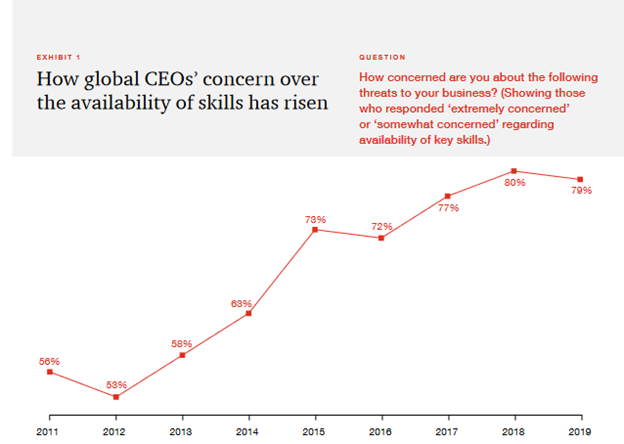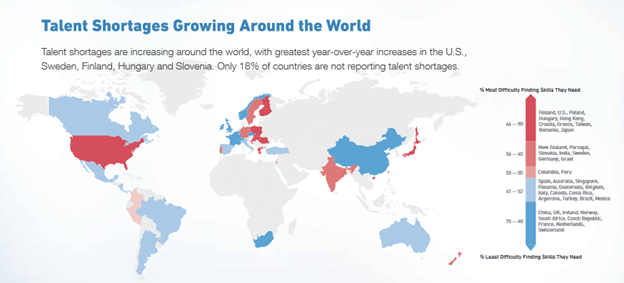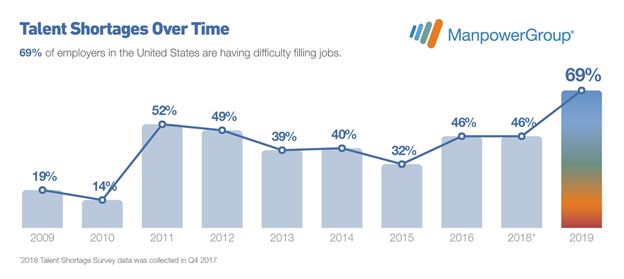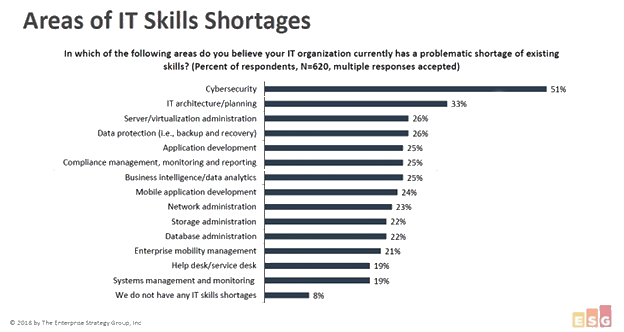The shortage of IT specialists is hardly a new problem. In fact, top executives have been voicing their concerns over the lack of tech skills for over a decade, going from 56% in 2011 to a whopping 79% in 2019, as shown in the graphic below.
Source: PwC
Now the COVID-19 pandemic has turned almost every business into a tech company. Several years of digital transformation have been crammed into one as organizations across the globe are increasingly adopting digital solutions to stay connected with their customers and support the remote workforce.
This acceleration of digitization takes the problem of tech talent scarcity to a whole new level. Throughout the world, small businesses and tech giants alike are struggling to attract and retain the right tech skills in order to stay competitive. Today, the global IT skills shortages already amount to 40 million qualified professionals, and this number is expected to reach 85.2 million workers by 2030.
However, some regions suffer from more severe tech talent shortages than others. The graphics below uses the data from a survey by ManpowerGroup to show the scarcity of tech skills around the world.
Source: ManpowerGroup
North America
In North America, the United States is suffering from the tech talent crisis the most, with the skills shortage being at a ten-year high. According to the same survey, 69% of employers were struggling to fill positions in 2019, with skilled trades, IT, and sales being the hardest roles to cover.
Source: PR Newswire
By the end of 2020, there were estimated 1.4 million unfilled computer science jobs. This number is even more impressive given that there are only 400,000 graduates a year. Another factor that hampers the development of the US tech market is staff turnover, which is the highest among other industries ranking at 13.2%.
According to the Bureau of Labor Statistics, the shortage of engineers in the US will exceed 1.2 million by 2026. This deficit in skilled IT specialists could put the country at the risk of losing $162 billion in unrealized revenue.
The Nordics
While ICT specialists are wanted throughout the entire region, some European countries experience the talent gap on a larger scale. Finland, for instance, reports an acute labor shortage in the tech field since the IT industry has become the country’s biggest sector. The Technology Industries of Finland, a lobbying organization for the IT industry, warns that the sector would need around 130,000 ICT professionals over the next decade.
Another Nordic country at the risk of IT specialists shortage is Sweden. With Skype, Spotify, Electrolux, Ericsson, and other tech giants under its belt, Sweden is often seen as the Silicon Valley of Europe. But the country struggles to find the tech talent it needs — according to a report by Swedish IT and Telecom Industries company, the IT competence shortage will reach 70,000 specialists by 2022 if no measures are taken.
Eastern Europe
As for Eastern Europe, the most severe shortage of skilled tech specialists is felt in Germany, Poland, Hungary, and Croatia. For instance, in Germany the number of open IT positions has more than doubled just within three years, rising from 55,000 jobs in 2017 to 124,000 jobs in 2020. And given the aging population and low birth rates, Germany’s workforce is expected to reduce by nearly four million by 2030.
Western Europe
In the UK, tech recruitment agencies and individual experts are worried about the looming digital skills shortage disaster. As the UK’s economy begins to show the first signs of post-pandemic recovery, the tech sector is growing at a faster pace than any other. This means an increased demand for skilled tech workers — since March 2020, over 100,000 new tech jobs have been created. If no efforts are made to upskill the workforce, the UK risks losing £141.5 billion in GDP over the next decade.
Switzerland also experiences skills shortages that have risen by 22% in the past three years. According to ICTswitzerland, for every unemployed tech professional, there are four vacancies. By 2028, Switzerland will need to add 117,900 ICT specialists to its workforce.
The Middle East
In this region, the leading position in terms of talent shortage belongs to Israel. Home to 6,000 startups, the country has a huge demand for skilled software developers. According to the Israel Innovation Authority, the country is in need of additional 18,500 tech professionals. The general long-term goal for Israel is to increase the share of skilled high-tech workers from 9.6% to 15% of the global workforce, which would be about 50% more than the current situation.
East Asia
Among Asian countries, the scarcity of IT talent is very prominent in Singapore where 56% of employers admit difficulties with recruiting. Singapore is quickly emerging as an important tech hub in Asia as startups and tech giants are moving to the island state. But tight hiring policies and COVID-induced traveling restrictions impede overseas hiring and exacerbate talent crunch. Today, 500 tech vacancies are posted on job sites each week. And the ICT sector will need another 60,000 professionals over the next three years, according to the Minister-in-Charge of the Smart Nation Initiative.
The same problems riddle Hong Kong’s IT sector. As local talent moves away and fewer foreign high-skilled specialists arrive, employers find themselves competing over the same small talent pool. If the situation continues to worsen, the total unrealized output is estimated to reach the US $219.8 billion by 2030. And in the technology, media, and telecommunications sector alone, the failure to plug the talent could lead to the potential deficit of US $16.9 billion.
Australia
Australia is not immune to the tech skills crisis, too. In 2019, only 7,0000 students graduated with a degree in computer science. And while enrolments to CS degrees have increased by 9% over the past three years, this is far from enough to meet the demand. According to the ACS Digital Pulse Report, businesses will need over 520,000 more qualified ICT specialists by 2026.
What IT competencies are in most demand?
While different regions may have their own peculiarities when it comes to tech skills shortages, jobs that are most in-demand are shown on the graphics below.
Source: Carbonite
The cybersecurity skills gap has turned into a full-blown problem as the world is increasingly relying on technology amid the global pandemic. The industry would need another 4 million skilled cybersecurity specialists to close the gap. Other roles that are in high demand include system architects, cloud engineers, BI engineers and data analytics, web and mobile app developers.
Outsmarting talent shortages
There is no quick fix to the looming skills crisis. Well-thought-out initiatives and tight collaboration between the industry, education providers, and government are needed to bridge the skills gap and avoid lost revenues.
So, what exactly can businesses do?
- Reskilling and upskilling. Effective training programs can help the current workforce gain the skills and experience needed to succeed in tomorrow’s jobs. Savvy companies foster the continuous learning environment through in-house and out-house learning courses, schools, academies, boot camps, and conferences to match employees’ skillsets to the industry standards.
- Rethinking the local tech talent pipeline. As we have discussed earlier, there is a huge mismatch between the number of CS graduates and the number of open tech vacancies. What’s more, the curriculum is often outdated and doesn’t teach students the modern tech stack. Some companies are re-considering the four-year degree requirement and exploring tech apprenticeships to fill their pipelines with viable candidates.
- Leveraging outsourcing. While reskilling initiatives and tech apprenticeships are an important step towards overcoming the skills shortages, they take some time to bring positive results. That’s why many companies choose to swim in a wider talent pool and hire the right talent abroad. In addition to closing the expertise gap, outsourcing software development services enables businesses to cut development costs and accelerate time to market.
- Adopting low-code and no-code platforms. Low-code/no-code platforms are visual software development environments that allow non-tech users to create business-ready applications without coding. By 2024, low-code app development is expected to account for 65% of all application development.
Wrapping up
The pandemic has forever changed the employment scene, making businesses completely rethink how they operate and accelerate digital transformation.
With the greater reliance on technology across verticals and domains comes the need for tech talent that would support digital initiatives. Today, the stakes for high-skilled tech professionals are high. The shortage of cybersecurity experts alone will reach 1.8 million by 2022. Among the countries that report the greatest increase in year-to-year shortages are the US, Finland, Hong Kong, Sweden, Germany, and others.
The shortage of IT talent is the biggest barrier towards adopting emerging techs, accelerating innovation. Elinext offers mature expertise across a variety of domains to help businesses build cutting-edge software solutions and gain a competitive advantage.













